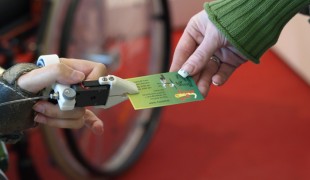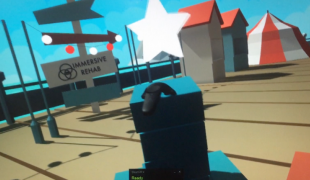- 9348
- 641
- 15
- 38
- 0
- Help Ukraine
About the solution
The students had two approaches to solve this problem: Emily bought a $300 robot arm, which she would reprogram so that Katelyn could control it with a joystick. Michael chose a more mechanical approach, working with PVC pipes and joints because he thought that would feel more natural and independent, to extend Katelyn’s reach. They ended up choosing the approach created by Michael.
The students are part of a program called SERO (Student Engineers Reaching Out). SERO grew out of a national service-learning design program in which teams of students partner with local service organizations to address human and community needs. The project with Katelyn began because her occupational therapist from Memorial Neurological Outpatient Therapy, Heather Beaver, heard about SERO and contacted them, asking for help.
Katelyn was riding a paddleboat with her stepbrother, in 2006, when a storm whipped out of nowhere and unleashed a lightning bolt that struck her.
She suffered severe burns, and was airlifted to two different hospitals. Katelyn stayed in a coma-like state for months, and her brain was severely shocked. The doctors told her mother, Julie Noblitt, that her daughter would never walk or talk again. The traumatic brain injury was permanent, and her short-term memory was affected, as was physical movement. Ten years later, Katelyn has control of her arms when held close to her torso, but when she extends them, ongoing nerve damage causes tremors that make controlling a fork or spoon nearly impossible.
“When we eat out at a restaurant, I’ve seen her turn away from the other people there so they can’t see her being fed and eating. It breaks my heart. This project is about self-esteem, giving her the control to eat on her own”, Julie explained.
The team then met with the patient to try the latest refinements to the PVC pipe system, which ended up being the most adequate solution. Michael clamped the device to the table while Emily helped Katelyn attach a Velcro strap to secure her right arm into the handle portion.
Emily brought brownie balls and fresh fruit so that Katelyn could try and eat by herself using her new gadget.
She pushed down to stab a piece of fruit, and the new spring pushed the fork back up while she manipulated the joints to twist the fork toward her mouth. Using both arms, she found better control.
The process would take some practice, but it got an immediate thumbs up from Katelyn. Next, she stabbed a blackberry and maneuvered the fork to pop it into her mouth.
Michael explained that he would make a few more changes based on the latest results and give the device to Katelyn to practice during the summer. She could give feedback to the SERO group that will work to improve it next year.
Katelyn leaned over her iPad and typed a message: “Like it. I’m so very happy.”
More info: http://bit.ly/2jngzca
Adapted from: http://ntrda.me/2wYZokk
https://youtu.be/tuAETFgNMPk
This solution shall not include mention to the use of drugs, chemicals or biologicals (including food); invasive devices; offensive, commercial or inherently dangerous content. This solution was not medically validated. Proceed with caution! If you have any doubts, please consult with a health professional.
DISCLAIMER: This story was written by someone who is not the author of the solution, therefore please be advised that, although it was written with the utmost respect for the innovation and the innovator, there can be some incorrect statements. If you find any errors please contact the patient Innovation team via info@patient-innovation.com
-
-
795
-
0
-
15778

Aids for limited hand function
Grip
(SELF)-CARE: EATING: Eating independently.
(SELF)-CARE: DRINKING: Drinking independently.
Paralysis
Spinal Cord and Nerve Root Disorders
Cervical spinal cord injury/Tetraplegia
Assistive Daily Life Device (to help ADL)
Assistive Technology access
Difficulty coordinating movements
Stiffness or rigidity (difficulty moving)
Paralysis of the legs and lower body
Muscle weakness
Loss of balance
Restoring mobility
Managing Neurological Disorders
Recovering from Traumatic Injuries
Maintaining Balance and Mobility
Neurology
Germany
-
-
-
703
-
0
-
17713

Glove to help control tremors
Grip
(SELF)-CARE: EATING: Eating independently.
(SELF)-CARE: DRINKING: Drinking independently.
Parkinson's Disease
Assistive Daily Life Device (to help ADL)
Body-Worn solutions (Clothing, accessories, shoes, sensors...)
Gait abnormalities (e.g., walking difficulties, unsteady gait)
Tremors
Muscle cramps or spasms
Difficulty coordinating movements
Muscle weakness
Cognitive impairment
Restoring mobility
Promoting self-management
Managing Neurological Disorders
Caregiving Support
Neurology
United Kingdom
-
-
-
409
-
0
-
4572

Helping people affected by neurological conditions live more independent lives again with our digital therapies for neurorehabilitation.
CAREGIVING
(SELF)-CARE: EATING: Eating independently.
(SELF)-CARE: DRINKING: Drinking independently.
(SELF)-CARE: HYGIENE: Maintaining personal hygiene
BODY BALANCE: Maintaining body balance
Multiple Sclerosis
Spinal Cord and Nerve Root Disorders
Stroke
Assistive Technology access
3d Printed
Treatment/Surgical device
Website
Muscle cramps or spasms
Difficulty coordinating movements
Stiffness or rigidity (difficulty moving)
Muscle weakness
Anxiety
Fatigue
Cold hands or feet
Restoring mobility
Rehabilitating After Stroke
Managing Neurological Disorders
Recovering from Traumatic Injuries
To improve Treatment/Therapy
Cardiology
General and Family Medicine
Intensive Care Medicine
Neurology
Physical Medicine and Rehabilitation
United Kingdom
-
 en
en